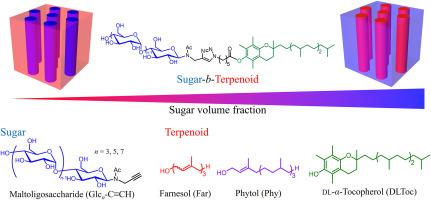具有优势糖体积分数的麦芽糖低聚糖基块共聚物的微相分离:对相行为的全面理解
IF 12.5
1区 化学
Q1 CHEMISTRY, APPLIED
引用次数: 0
摘要
由低聚糖和疏水萜类块组成的块段共聚物(BCOs)具有不同形态的微相分离结构,具有亚10nm的周期性,从而使它们在一系列纳米技术应用中具有兴趣。然而,它们的微相分离行为尚未在广泛的糖体积分数范围内得到充分阐明,特别是关于富糖制度。本研究采用0.41 ~ 0.69的糖体积分数,系统研究了由麦芽糖低聚糖(麦芽糖三糖、麦芽糖二糖和麦芽糖七糖)和疏水萜类块(法尼醇、叶甾醇和DL-α-生育酚)组成的富糖BCOs的微相分离行为。采用小角x射线散射(SAXS)和掠射x射线散射(SAXS)分别鉴定了体态和薄膜态的多种纳米结构,包括片层状结构、富糖旋转结构、六边形穿孔片层结构和六边形填充柱状结构。通过将推导出的富糖体系的相行为整合起来,构建了相图,为预测糖基嵌段共聚物/共聚物体系的自组装形态提供了有用的指导。本文章由计算机程序翻译,如有差异,请以英文原文为准。

Microphase separation in maltooligosaccharide-based block co-oligomers with dominant sugar volume fractions: Toward a comprehensive understanding of the phase behavior
Block co-oligomers (BCOs) consisting of oligosaccharides and hydrophobic terpenoid blocks exhibit microphase-separated structures of various morphologies with sub-10 nm periodicity, thereby rendering them of interest for use in a range of nanotechnological applications. However, their microphase separation behaviors have yet to be fully elucidated across a broad range of sugar volume fractions, especially with regard to sugar-rich regimes. In this study, the microphase separation behaviors of sugar-rich BCOs composed of maltooligosaccharides (maltotriose, maltopentaose, and maltoheptaose) and hydrophobic terpenoid blocks (farnesol, phytol, and DL-α-tocopherol) were systematically investigated using sugar volume fractions ranging from 0.41 to 0.69. Small-angle X-ray scattering (SAXS) and grazing incidence SAXS were employed to identify a variety of nanostructures in both the bulk and thin-film states, including lamellar, sugar-rich gyroid, hexagonally perforated lamellar, and hexagonally packed cylindrical structures. Through integration of the deduced phase behaviors in the sugar-rich regime, phase diagrams were constructed to provide useful guidance for predicting the self-assembled morphologies of sugar-based block copolymer/co-oligomer systems.
求助全文
通过发布文献求助,成功后即可免费获取论文全文。
去求助
来源期刊

Carbohydrate Polymers
化学-高分子科学
CiteScore
22.40
自引率
8.00%
发文量
1286
审稿时长
47 days
期刊介绍:
Carbohydrate Polymers stands as a prominent journal in the glycoscience field, dedicated to exploring and harnessing the potential of polysaccharides with applications spanning bioenergy, bioplastics, biomaterials, biorefining, chemistry, drug delivery, food, health, nanotechnology, packaging, paper, pharmaceuticals, medicine, oil recovery, textiles, tissue engineering, wood, and various aspects of glycoscience.
The journal emphasizes the central role of well-characterized carbohydrate polymers, highlighting their significance as the primary focus rather than a peripheral topic. Each paper must prominently feature at least one named carbohydrate polymer, evident in both citation and title, with a commitment to innovative research that advances scientific knowledge.
 求助内容:
求助内容: 应助结果提醒方式:
应助结果提醒方式:


